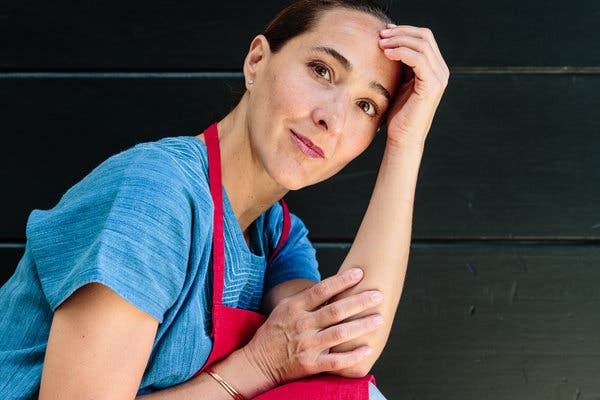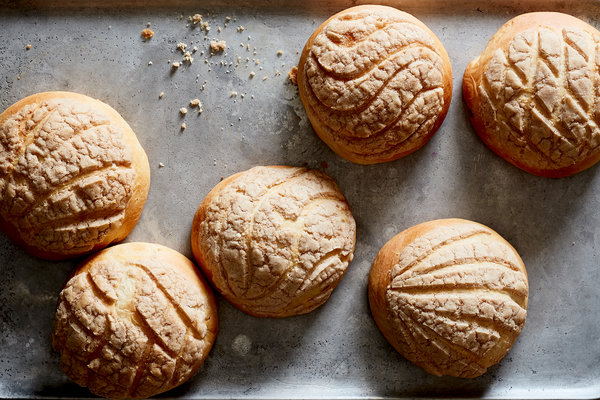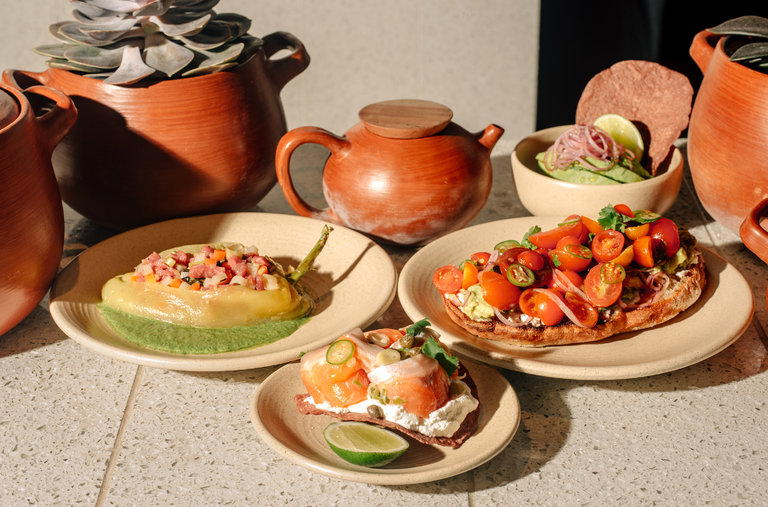SAN FRANCISCO — Gabriela Cámara is having a very good year.
Five years after she moved to the United States from her native Mexico, she is at the tipping point of world culinary fame. Her 20-year-old restaurant, Contramar, is both a beloved institution and a power-lunch destination: the Union Square Cafe of Mexico City. Her San Francisco restaurant, Cala, has established her here as both an eloquent translator of modern Mexican food and an advocate for social justice: She provides health insurance and other benefits to all full-time employees, many of whom are recruited through job programs for the formerly incarcerated.
A glowing documentary film about the restaurants, “A Tale of Two Kitchens,” executive-produced by the actor Gael García Bernal, premiered two weeks ago on Netflix. She has just published a cookbook, “My Mexico City Kitchen” (Lorena Jones Books). This summer she will open a restaurant in Los Angeles with Jessica Koslow of Sqirl, whose casually fabulous cooking mirrors her own.
And last month, she got a bigger platform: The Mexican government named Ms. Cámara, 44, to a new Council of Cultural Diplomacy, composed of people who bring global prestige to Mexican culture. The duties are vague, but the recognition is unmistakable. The group includes artists and academics of all kinds, like the architect Enrique Norten; Elisa Carrillo Cabrera, a principal dancer of the Staatsballett Berlin; and the sociologist Silvia Giorguli Saucedo, the first woman president of the Colegio de México.

The chef Gabriela Cámara at her San Francisco restaurant, Cala.CreditAlanna Hale for The New York Times
Ms. Cámara plans to move back to Mexico City this summer to advise the Mexican president, Andrés Manuel López Obrador, a lifelong family friend, on food policy. “To have a president who cares about food is an incredible opportunity for Mexico,” she said.
First, she will have to face some criticism over her past role in his administration. (More on that later.) But she hopes to serve as an unofficial domestic advocate for all aspects of Mexican cuisine — traditional cooking, modern restaurants, tourism opportunities and the challenges posed by global food manufacturers, agribusiness and climate change.
“I want to be like Human Rights Watch, but for Mexican food,” she said. The new rift between Mexico and the United States over tariffs, including on staples like avocados and tomatoes, make this an especially fraught time to take on food politics.
She is undaunted. Her new book’s subtitle, “Recipes and Convictions,” says a lot about her: Ms. Cámara is as engaged in opinions about and interpretations of Mexican food as she is in cooking it.
The book reflects her own real-world cooking, she said, not strict Mexican tradition. There are mini-essays about sustainable seafood, the role played by lime juice, and the unorthodox notion that you can fold anything in a tortilla and call it a taco. Instead of knife skills and culinary experience — she never went to cooking school or worked in a restaurant that wasn’t her own — she brings to the table a highly educated global palate and great taste in design and food alike.
Contramar itself is an interpretation. In 1998, Ms. Cámara set out to recreate the beachside restaurants she loved as a child on Mexico’s Pacific Coast, but fitted with formal service and chic décor to work perfectly in a big city.
Contramar and Cala, which she will continue to run, both hit the sweet spot of being relaxed but sure-handed, especially in her classic dishes: tostadas of raw fish with slivers of avocado and hints of chipotle, butterflied grilled fish painted with red and green salsas, and aguachiles (briny, citrusy ceviches). Each component in a dish — the seafood, the corn masa, the chile — shines.
“What Gabriela does is personal but timeless,” said Enrique Olvera, the chef at Pujol in Mexico City, Cosme in New York and other influential modern Mexican restaurants. “Contramar feels like it could exist in the future or in the past.”
Despite her already long and successful career, Ms. Cámara does not entirely consider herself a chef. She’s a lifelong home cook, raised by hippie parents who grew their own food and cooked in solar ovens.
She is also a gregarious combination of entrepreneur, activist and frazzled parent on a book tour — the kind of person who always has yeast in her refrigerator, but doesn’t stop long enough to consider that it might have died.
That happened the first time she tried to teach me to bake conchas, soft buns with a crunchy, sweet topping that are a national breakfast staple.
“No one in Mexico City would make conchas at home,” she said, throwing up her floury hands in despair when the starter failed to launch. “Just like no one in New York would make bagels when you can go out and buy them.”
Her bright home kitchen, perched on a hill above Mission Dolores Park, also held fermenting cacao beans, mesquite flour and fluffy tamales. (Later, with fresh yeast, the recipe produced light, barely vanilla-scented buns, with the sugared shell pattern on top that gives conchas their name.)
American books about Mexican food have long been preoccupied with authenticity: Diana Kennedy and Rick Bayless set the modern standard for writing respectfully as outsiders. But Ms. Cámara can cheerfully ignore that, adapting recipes according to her own taste and skills. She does not claim that hers is an “authentic Mexican cookbook,” only that it is authentic to her own experience. And, not insignificantly, it is being published first in English.
Ms. Cámara’s mother grew up in Philadelphia, and Ms. Cámara speaks English just as fluently, and almost as fast, as she does Spanish. It’s one reason she can skilfully represent modern Mexico in the culinary world, which has come to speak mainly in English since the advent of the internet.
But her relationship with American identity isn’t frictionless.
“Opening a Mexican restaurant in the United States is a paradox no matter how you look at it,” she says in the documentary. “Yes, there is a lot of curiosity and respect for authentic Mexican food. On the other hand, there is a larger culture that despises Mexicans.”
Globally, enthusiasm for Mexican food is strong, but respect for it has been a long time coming. Many people’s ideas about Mexican cuisine have been informed by third- and fourth-hand translations through the filter of American fast food.
But as more people have experienced Mexico’s extraordinary synthesis of Aztec, Mayan, European, Middle Eastern and global influence, and as chefs all over Latin America have begun to celebrate the vast region’s native cuisines, that is changing. In 2017, when the Danish chef René Redzepi transferred his acclaimed Copenhagen restaurant Noma to the Yucatán Peninsula, and served diners from all over the world one perfect corn tortilla as part of a $600 tasting menu, the “elevation” of Mexican cooking by a European chef was controversial. But it also reflected a new respect for and interest in the richness of Mexican food beyond the country’s borders.
Ms. Cámara intends to keep moving that needle. Her sights are high, and her access is exceptional for a chef. She comes from an old and influential family; an ancestor, Carlos Pellicer Cámara, was a famous poet and intellectual, and her parents have been prominent leftist academics since the 1970s. She has been close to the president and his family since childhood.
But on her return, she will have to face some fallout from her political debut. Last August, just after the election, Mr. Lopéz Obrador appointed Ms. Cámara to oversee Mexico’s tourism board.
The country’s hotels, resorts, museums, restaurants, galleries and countless other destinations are estimated to produce more than 15 percent of the gross national product. With more than 20 international offices, the Consejo de Promoción Turística de México was spending hundreds of millions of dollars a year (raised by taxes paid by foreign tourists) to promote them. Like many such agencies, it had grown to be unnecessarily complex and notoriously wasteful.
“It was completely out of control,” Ms. Cámara said. She recommended that the board be closed entirely.
Mr. López Obrador, who campaigned on a promise to reduce excessive government spending, dissolved the board, called VisitMexico, shortly after his inauguration. Most of its offices have been closed, and its remaining funds — about $300 million — were diverted to the Tren Maya, a much-criticized new rail system that will ferry visitors to the south of the country, which is relatively undeveloped for tourism.
Several tourism industry insiders, speaking on the condition of anonymity in order to protect their relationships with Ms. Cámara, said in interviews that they worried that without official support for tourism, Mexican culture could lose the spotlight they have worked so hard to gain. No plans to replace the agency have been announced.
Since the cuts are part of Mr. Lopez Obrador’s austerity program, Ms. Cámara is not being unilaterally blamed for these developments. But her high-profile combination of inside access and inexperience has made some colleagues wary of her return.
Ms. Cámara said she believed that fundamental institutional change was the only way to make Mexico a fair and prosperous society. “I believe that we have to change the priorities of tourism so that the people who do the work can benefit from it,” she said.
Still, Contramar is so beloved by the cognoscenti of Mexico City that it is hard to imagine that Ms. Cámara will not be embraced as a prodigal daughter. On any given day — Contramar is open only for lunch — its patrons may include the city’s mayor, its biggest telenovela stars and enough power players to make it the equivalent of New York’s Four Seasons in its heyday, only more fun, and with much better food.
“The magic is that it captured the Mexican family lunch table,” said Bertha González Nieves, who runs the small-batch tequila company Casa Dragones. Lunch, especially on weekends, is still the occasion for most ceremonial meals, and an important part of the shared culture.
Specifically, Contramar captures the family table on a beach vacation: a large group under a leafy palapa, with freshly caught fish, an outdoor grill and a siesta to look forward to. Even a business lunch in Mexico can easily last two hours; at Contramar, stragglers are still being shooed out at 7 p.m.
The food is usually described by what it is not — fussy, high-end, modernist, unique — rather than what it is, which is simple but refined, and perfectly designed for pleasure. Like Alice Waters, Ms. Cámara is not a culinary innovator, but a curator. She has bridged Mexican tradition and modern taste with such a clearly articulated vision that she is beginning to achieve global stature representing Mexico, alongside chefs like Mr. Olvera, Daniela Soto-Innes and Elena Reygadas.
Women chefs have long dominated the restaurant scene in Mexico, Mr. Olvera said, unlike in the United States. “I found it very strange when I came back,” said Mr. Olvera, who attended the Culinary Institute of America and worked in fine-dining kitchens in New York in the 1990s. “As a male chef, suddenly I was the one who stuck out.”
Mexico’s venerable French, Spanish and Italian restaurant kitchens are mostly headed by men. But native culinary traditions have always been passed on by women, mostly in home kitchens. As Mexican cuisine becomes more celebrated everywhere, the nation’s female chefs have a chance to shine.
Ms. Nieves, who worked as a consultant at Booz Allen Hamilton and at Jose Cuervo for a decade before starting her tequila company, said Ms. Cámara, like herself, represents a new generation of Mexican women who are educated, multilingual, ambitious and moving into leadership roles in high-stakes businesses like hospitality and tourism.
“From outside the window, it might appear that many women are still in traditional roles,” she said. “But there is a lot of power in a Mexican kitchen.”
Recipes: Conchas (Mexican Morning Buns) | Tacos al Pastor










